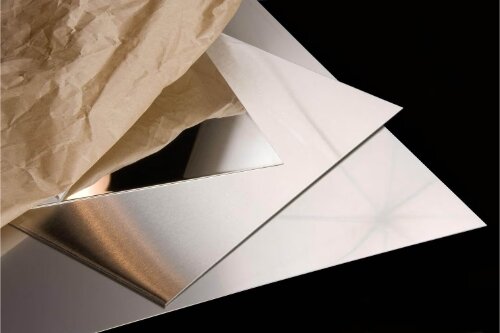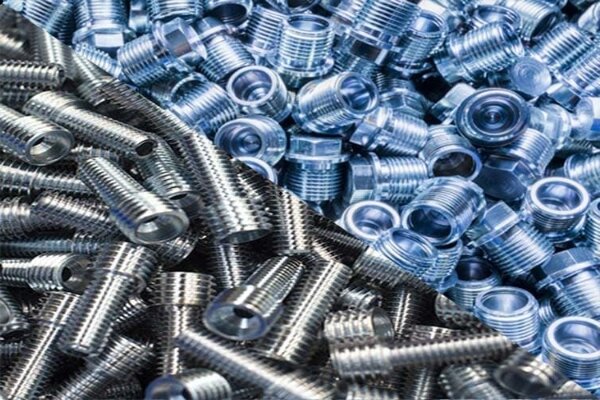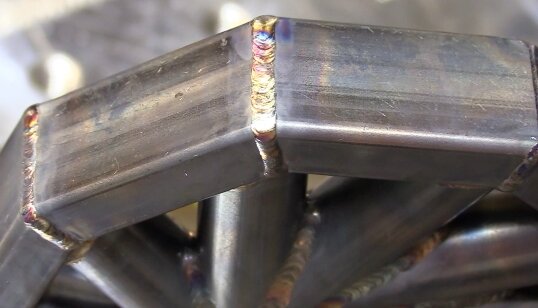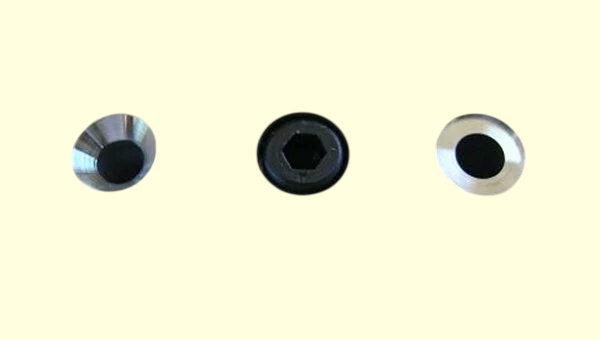단단한 소재를 초정밀로 절단하는 데 어려움을 겪고 계신가요? 엄격한 공차를 충족하지 못하는 기존 방식에 좌절하셨나요? 와이어 EDM 절단이 해답을 제시합니다. 이 고급 가공 공정은 복잡한 디자인과 까다로운 소재에 대해 탁월한 정확도를 제공함으로써 산업에 혁신을 가져옵니다.
이 혁신적인 기술로 제조 공정을 개선하는 방법에 대해 자세히 알아볼 준비가 되셨나요? 계속 읽어보면서 와이어 EDM 절단의 장점과 응용 분야를 살펴보세요.
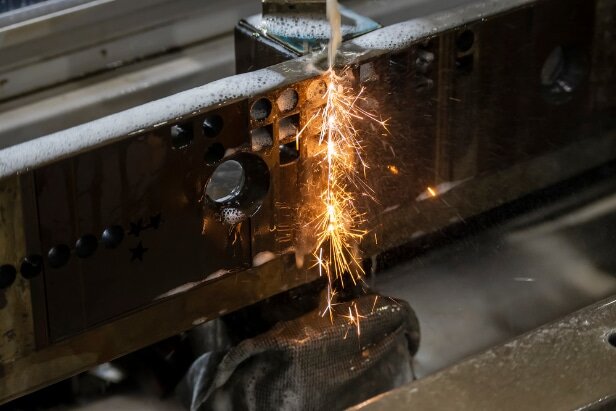
와이어 EDM 커팅이란?
와이어 EDM 절단은 특수한 방전 공정입니다. 와이어 EDM은 가늘고 전기적으로 충전된 와이어를 사용하여 제어된 전기 스파크를 통해 전도성 금속을 절단합니다. 이 공정은 공작물을 탈이온수에 담그는 동안 와이어가 직접 접촉하지 않고 정밀한 절단을 생성합니다.
이 비접촉 방식은 열처리 없이 사전 경화된 소재의 복잡한 형상을 구현할 수 있습니다.
와이어 EDM은 어떻게 작동하나요?
와이어 EDM은 전기 방전을 사용하여 재료를 제거하는 정밀 가공 공정입니다. 이 매혹적인 공정이 어떻게 작동하는지 자세히 알아보겠습니다.
프로세스 설명: 전기 방전 및 이물질 제거
와이어 EDM 절단에서는 일반적으로 황동으로 만들어진 얇은 와이어가 절단할 재료를 통과합니다. 와이어는 전기로 충전되어 프로그래밍된 경로를 따라 이동하면서 일련의 스파크를 생성합니다. 이 스파크는 매우 뜨거워서 재료의 작은 부분을 녹이고 증발시켜 정밀한 절단을 만들어냅니다.
EDM 작업의 단계
- 설정: 공작물이 기계에 단단히 배치되고 와이어가 재료를 통과합니다.
- 프로그래밍: 컴퓨터 프로그램이 만들어져 와이어가 지나갈 경로를 제어하고 절단 모양과 치수를 결정합니다.
- 가공: 와이어가 프로그래밍된 경로를 따라 이동하면서 재료를 부식시키는 일련의 전기 방전을 생성합니다. 유전체 유체는 해당 영역을 냉각하고 청소하는 데 사용됩니다.
- 마무리 손질: 절단이 완료되면 공작물을 제거하고 원하는 품질을 보장하기 위해 최종 조정 또는 마무리 프로세스를 수행합니다.
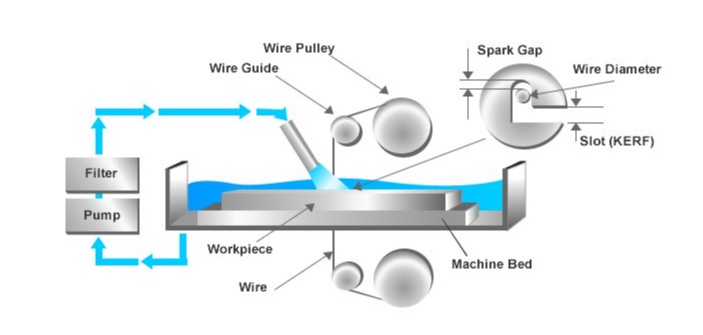
와이어 EDM 머신의 구성 요소
와이어 EDM 기계는 복잡하며 고정밀 절단을 달성하기 위해 여러 핵심 부품이 조화롭게 작동해야 합니다. 와이어 EDM 기계를 구성하는 필수 부품을 살펴보세요.
CNC 도구
와이어 EDM 장비의 핵심은 와이어의 움직임과 장비의 전반적인 작동을 지시하는 CNC 시스템입니다. CNC 시스템은 설계와 프로그래밍을 해석하여 와이어를 매우 정밀하게 안내합니다.
전원공급장치
와이어 EDM 기계의 전원 공급 장치는 소재를 침식하는 방전을 생성하는 역할을 합니다. 전원 공급 장치는 와이어를 통해 전기 에너지 펄스를 보내면 스파크가 발생하여 공작물의 작은 부분을 녹입니다.
와이어
일반적으로 황동 또는 구리로 만들어진 와이어는 전기 방전이 통과하여 재료를 절단하는 전극 역할을 합니다. 와이어는 직경이 보통 0.1~0.3mm로 매우 가늘며 공작물을 통해 지속적으로 움직입니다.
유전체 매체
유전체 매체는 종종 특수하게 제조된 오일 또는 탈이온수로, 와이어와 공작물 주변을 냉각하고 세척하는 데 사용됩니다. 유전체 유체는 와이어와 공작물 사이의 아크를 방지하고 절단 공정을 안정화하며 스파크에 의해 생성된 이물질을 제거합니다.
전극
전극은 구멍이나 복잡한 윤곽을 형성하는 등 특정 형상을 만드는 데 사용할 수 있습니다. 이러한 전극은 공작물에 전기를 전도하여 재료 제거에 필요한 방전을 생성하는 방식으로 작동합니다.
EDM 와이어 커팅과 기존 EDM의 차이점
와이어 EDM과 기존 EDM은 모두 방전 가공 공정의 동일한 제품군에 속하지만, 성능과 응용 분야에 영향을 미치는 주요 방식에서 차이가 있습니다. 몇 가지 중요한 측면에서 두 공정을 어떻게 비교하는지 살펴보겠습니다.
전극
기존 EDM은 흑연이나 구리와 같은 전도성 재료로 만든 고체 전극을 사용하는 반면, 와이어 EDM은 다이아몬드 가이드 사이를 지속적으로 이동하는 얇은 금속 와이어를 사용합니다.
기존 EDM 전극은 원하는 캐비티 형태에 맞게 전극을 미리 성형해야 하는 반면, 와이어 전극은 보다 정밀한 절단과 복잡한 패턴을 구현할 수 있습니다.
가공 속도
와이어 EDM은 맞춤형 툴링이나 전극 성형이 필요하지 않으므로 설정 및 생산 시간이 단축됩니다. 기존 EDM은 가공을 시작하기 전에 전극을 특수하게 성형해야 하므로 전체 처리 시간이 길어집니다.
정확성
정밀도에 있어서는 와이어 EDM이 탁월합니다. 와이어의 연속적인 움직임으로 공차가 0.002mm 이하로 매우 정밀하게 절단할 수 있어 매우 복잡한 디자인에 이상적입니다.
기존 EDM도 좋은 정확도를 얻을 수 있지만, 특히 더 세밀하거나 복잡한 컷에서는 일반적으로 와이어 EDM에 비해 정확도가 떨어집니다.
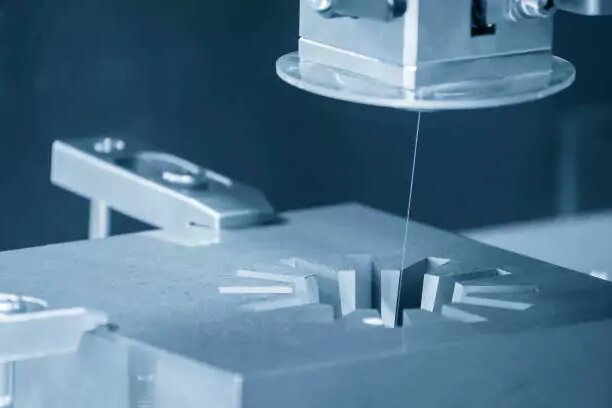
와이어 EDM 가공의 장단점
와이어 EDM 가공은 특히 정밀도와 다양성 측면에서 많은 이점을 제공합니다. 하지만 다른 제조 공정과 마찬가지로 한계가 있습니다. 다음은 가공 요구 사항에 따라 와이어 EDM을 사용할 때의 장단점을 분석한 것입니다.
와이어 EDM 가공의 장점
- 높은 정밀도: 와이어 EDM은 매우 엄격한 공차(±0.0001인치)를 달성하므로 복잡한 디자인 및 복잡한 형상에 이상적입니다.
- 기계적 스트레스 없음: 비접촉식 공정으로 공작물에 변형이나 응력이 가해지지 않아 무결성을 유지합니다.
- 다재: 텅스텐, 티타늄, 공구강과 같은 단단한 재료를 미리 경화된 상태에서도 쉽게 절단할 수 있습니다.
- 버 없는 마감: 이 프로세스는 매끄러운 표면을 생성합니다. 버를 사용하여 2차 마무리의 필요성을 줄입니다.
- 단일 설정 효율성: 복잡한 형상을 한 번의 설정으로 구현할 수 있으므로 여러 가공 프로세스가 필요하지 않습니다.
와이어 EDM 가공의 단점
- 재료 제한: 플라스틱, 복합재 및 비금속 소재를 제외한 전도성 소재만 가공할 수 있습니다.
- 높은 비용: 전선 및 유전체 유체와 같은 소모품은 전기 소비와 함께 운영 비용을 증가시킵니다.
- 열 효과: 이 과정에서 특정 재료에 열 영향 구역(HAZ) 또는 산화물 층이 생성되어 추가 세척 또는 가공이 필요할 수 있습니다.
- 유지 보수 요구 사항: 기계 성능을 유지하려면 전선, 필터 및 유전체 시스템을 정기적으로 유지 관리해야 합니다.
EDM에 적합한 소재
와이어 EDM은 특정 유형의 재료를 절단하는 데 특히 효과적입니다. 거친 재료로 작업할 수 있기 때문에 높은 정밀도가 필요한 산업에서 선호되는 선택입니다. EDM에 가장 적합한 재료와 재료를 선택할 때 고려해야 할 요소를 살펴보겠습니다.
전도성 재료: EDM을 위한 일반적인 선택
와이어 EDM은 절단 공정이 전기 방전에 의존하기 때문에 전기 전도성이 있는 재료가 필요합니다. EDM에 적합한 일반적인 재료는 다음과 같습니다:
- 공구강: 경도와 내구성으로 유명하며 금형과 금형에 자주 사용됩니다.
- 티타늄 합금: 가볍고 튼튼하여 항공우주 및 의료 산업에 이상적입니다.
- 텅스텐 카바이드: 매우 단단하여 툴링 애플리케이션에 적합합니다.
- 구리 및 황동: 전도성이 높아 미세한 마감에 사용되지만 더 많은 이물질을 생성할 수 있습니다.
- 인코넬 및 하스텔로이: 열과 부식에 강한 초합금으로 항공 우주와 같이 스트레스가 많은 환경에서 자주 사용됩니다.
공작물 크기 및 소재 두께 고려 사항
EDM용 재료를 선택할 때 공작물의 크기와 두께는 고려해야 할 중요한 요소입니다:
- 재료 두께: 와이어 EDM은 다양한 재료 두께를 절단하는 데 효과적이지만, 두께가 증가하면 효율성이 감소합니다. 두꺼운 재료를 절단하려면 더 많은 시간이 필요하고 와이어를 더 자주 교체해야 할 수 있습니다.
- 공작물 크기: 더 큰 공작물은 더 큰 EDM 장비로 수용할 수 있지만, 부품이 클수록 절단 시간도 길어진다는 점을 기억해야 합니다. 대형 부품의 경우에도 절단 정밀도를 유지할 수 있지만 생산 규모를 확장할 때 속도와 비용 효율성 측면에서 한계가 있습니다.
다양한 산업 분야의 EDM
와이어 EDM은 높은 정밀도를 달성하고 거친 재료를 절단할 수 있어 다양한 산업 분야에서 유용한 도구로 활용되고 있습니다. 몇 가지 주요 분야에서 와이어 EDM이 어떻게 적용되는지 살펴보겠습니다.
자동차 산업
- 정밀 엔진 부품: EDM을 사용하면 연료 인젝터 및 피스톤과 같이 복잡한 형상과 엄격한 공차를 가진 엔진 부품을 생산할 수 있습니다.
- 브레이크 부품: EDM은 극한의 조건과 반복적인 사용에도 견딜 수 있는 견고하고 안정적인 브레이크 부품을 보장합니다.
- 사출 금형 및 다이캐스팅 금형: 대시보드 및 범퍼와 같은 자동차 부품의 복잡한 디테일이 있는 금형을 제작하는 데 사용됩니다.
- 전기 자동차 부품: EDM은 모터 코어, 배터리 커넥터 및 기타 EV 전용 부품을 고정밀로 제조합니다.
의료 산업
- 수술 도구: EDM은 수술 도구의 복잡한 특징과 작은 구멍을 높은 정밀도로 생성합니다.
- 의료용 임플란트: 정형외과용 임플란트(예: 고관절 및 무릎 교체)를 위한 티타늄과 같은 단단한 금속을 가공하는 데 사용됩니다.
- 치과용 도구: 우수한 크라운, 브리지 및 어버트먼트를 생산합니다. 표면 마감.
- 복잡한 기능: 엄격한 공차와 우수한 표면 품질이 필요한 부품 가공에 이상적입니다.
항공우주산업
- 터빈 블레이드: EDM은 초합금으로 제작된 터빈 블레이드의 냉각 구멍을 가공하여 고온에서도 안정성을 보장합니다.
- 엔진 구성 요소: 연료 인젝터 및 컴프레서 디스크와 같은 정밀한 제트 엔진 부품을 생산합니다.
- 구조 부품: 항공기 안전을 위해 높은 정밀도가 요구되는 지지대, 프레임 및 보강재를 제작합니다.
- 항공 전자 시스템: 전자 시스템에 중요한 하우징, 커넥터 및 어셈블리를 제조합니다.
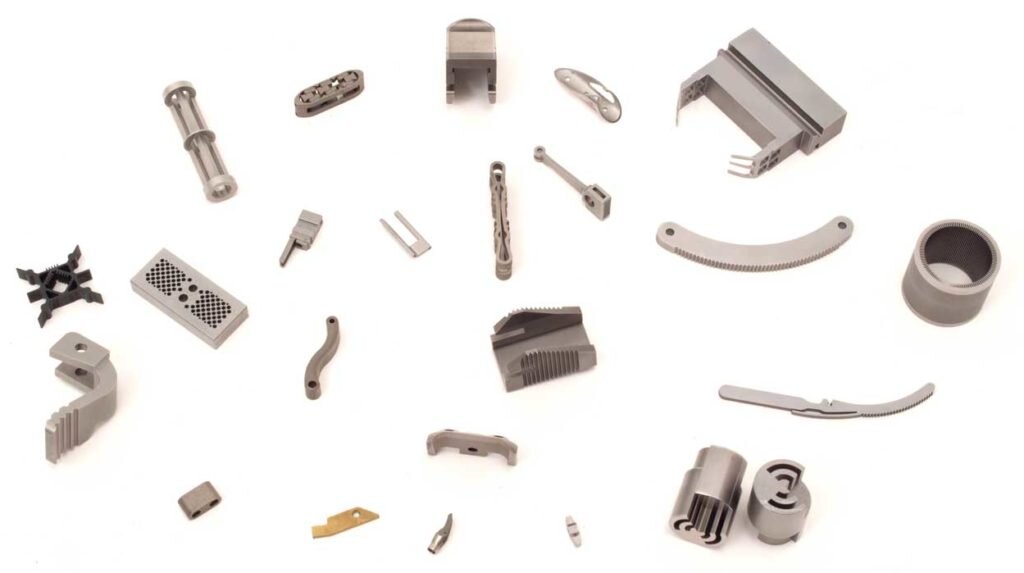
와이어 EDM을 사용할 때 고려해야 할 주요 요소는 무엇인가요?
와이어 EDM을 사용할 때 공정의 효율성과 정확성에 영향을 미칠 수 있는 몇 가지 중요한 요소가 있습니다. 이러한 요소에 적절히 주의를 기울이면 최적의 결과를 보장하고 장비의 수명을 연장할 수 있습니다. 다음은 몇 가지 주요 고려 사항입니다.
와이어 선택
- 재료: 황동은 비용 효율성과 전도성 때문에 일반적으로 사용되는 반면, 코팅 와이어(예: 아연 코팅 또는 층상)는 더 빠른 절단 속도와 더 나은 표면 마감을 제공합니다.
- 지름: 와이어가 얇을수록 정밀도는 높아지지만 끊어지기 쉬우므로 절단 속도가 느려집니다. 일반적인 직경 범위는 0.0008인치에서 0.012인치입니다.
- 인장강도: 고장력 와이어는 스트레스를 받아도 끊어지지 않아 더 빠르고 공격적인 커팅이 가능합니다.
전원 설정
- 펄스 지속 시간 및 전류: 이러한 매개변수를 조정하면 절단 속도, 표면 마감 및 와이어 마모에 영향을 미칩니다. 전류가 높을수록 속도가 빨라지지만 정밀도가 떨어질 수 있습니다.
- 듀티 사이클: 온타임과 오프타임의 균형을 맞춰 과열이나 전선 단선을 방지하면서 일관된 스파크 발생을 보장합니다.
- 전압: 적절한 전압 설정으로 절단 효율과 스파크 갭의 안정성이 향상됩니다.
머티리얼 포지셔닝
- 안정: 공작물을 단단히 고정하여 가공 중 움직임을 방지하여 정확한 절단을 보장합니다.
- 플러싱: 유전체 유체 흐름에 따라 적절하게 정렬하면 이물질을 효과적으로 제거하여 와이어 마모를 줄이고 정밀도를 유지합니다.
- 두께 고려 사항: 재료가 두꺼울수록 절단 속도가 느려지고 정확도를 유지하기 위해 세심한 매개변수 조정이 필요합니다.
결론
와이어 EDM 절단은 전도성이 있는 단단한 소재를 정밀하게 절단하는 데 매우 효과적인 공정입니다. 기계적 압력 없이 복잡한 모양과 엄격한 공차를 만들 수 있습니다. 와이어 선택, 전원 설정, 재료 배치와 같은 핵심 요소는 작업의 성공을 보장하는 데 중요한 역할을 합니다.
와이어 EDM으로 제조 공정을 개선하는 방법에 관심이 있으신가요? 문의하기 에 문의하여 프로젝트 요구 사항을 논의하고 요구 사항에 맞는 전문가의 조언을 받아보세요!
안녕하세요, 저는 케빈 리입니다

지난 10년 동안 저는 다양한 형태의 판금 제작에 몰두해 왔으며 다양한 워크숍에서 얻은 경험에서 얻은 멋진 통찰력을 이곳에서 공유했습니다.
연락하세요

케빈 리
저는 레이저 절단, 굽힘, 용접 및 표면 처리 기술을 전문으로 하는 판금 제조 분야에서 10년 이상의 전문 경험을 갖고 있습니다. Shengen의 기술 이사로서 저는 복잡한 제조 문제를 해결하고 각 프로젝트에서 혁신과 품질을 주도하는 데 최선을 다하고 있습니다.

